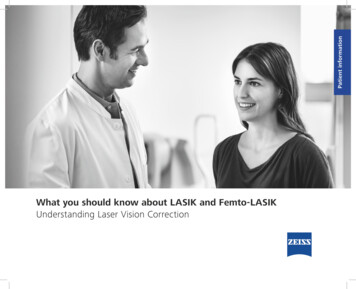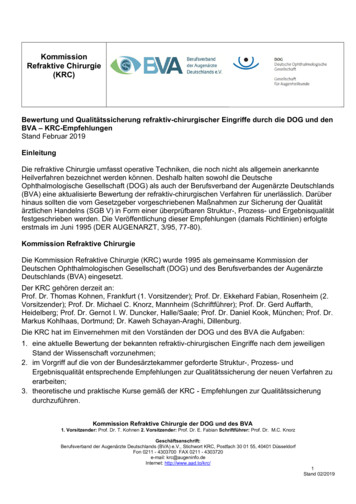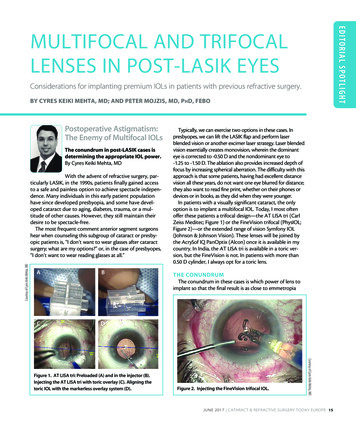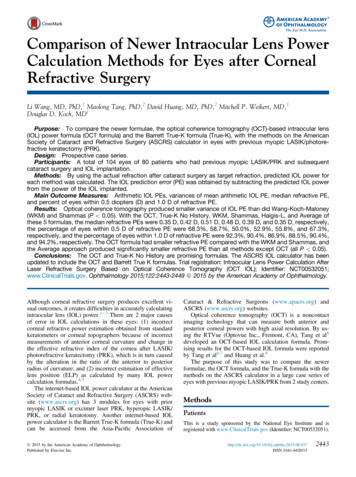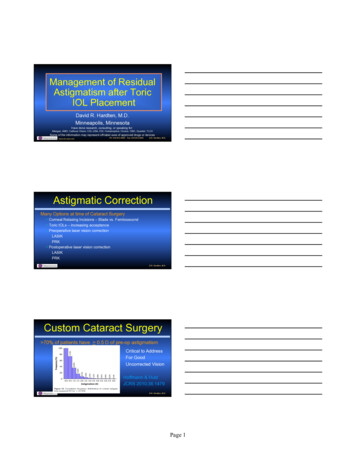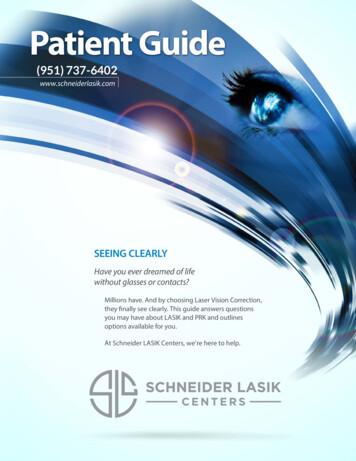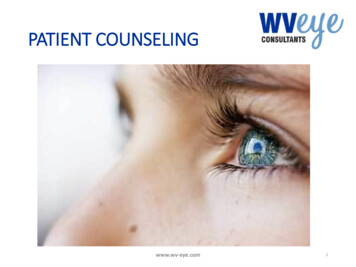
Transcription
LASIK/PRKPATIENTGUIDELOCAL. TRUSTED.COMMITED.LASER REFRACTIVE COSMETIC EYELID PREMIUM CATARACT
TRUE INDEPENDENCESeventy-four percent of Canadians required vision correction in 2016. With that numbercontinuing to rise, an increasing portion of Canadians must choose the corrective option bestsuited to their lifestyle. Laser eye surgery is a premium solution, optimizing vision for yourlifestyle. Dr. Conlon offers both LASIK and PRK as procedure options for his patients.Laser Assisted In-Situ Keratomileusis (LASIK), is a corrective procedure fornearsightedness, farsightedness, and astigmatism, reducing or eliminating the need forcorrective eye wear. The most common vision corrective surgery, LASIK refocuses lightentering the eye to a single point using a thin corneal flap, thus sharpening vision. Withminimal discomfort, vision is typically restored within 24 hours.Photorefractive keratectomy (PRK) is a similar procedure to LASIK, usually performedwhen a patient is not a LASIK candidate due to a thin, steep or irregularly-shaped cornea. PRKreshapes the cornea’s surface instead of creating a corneal flap. Providing similar vision benefits,LASIK is often the preferred procedure simply due to quicker visual recovery and return toactivities, as PRK requires a more extensive recovery.Ophthalmologist, Dr. M. Ronan Conlon, is the Medical Director of the Conlon EyeInstitute. Establishing his clinic in 1994, he offers innovative procedures treating a range of eyeconcerns, specializing in laser and traditional cataract surgery. He has performed over twentythousand refractive eye surgeries throughout his career.“Individuals want the freedom of choice regarding their eye care and I have developed mypractice around offering services that enhance one’s own lifestyle from a visual perspective.Everybody wants to see clearly.” – Dr. M. Ronan Conlon
WHAT REQUIREMENTS MAKE A GOODLASER EYE CANDIDATE?We offer complimentary consultations to assess eligibility for LASIK/PRK and toanswer patient questions. To be considered for laser eye surgery, a candidate mustexhibit: Healthy eyesAdequate corneal thickness18 years of age or aboveStable vision for a year or moreOverall good healthRealistic surgery expectationsWILLL IT HURT?Undergoing either procedure is painless; it does not require general anesthetic,just local anesthetic eye drops. After LASIK, mild irritation for a few hours is commonbut most patients do not require pain medication. With PRK, for a few days afterward,discomfort will occur as the eye's surface heals. This pain is managed by a soft “bandage”contact lens and pain relief medication.
HOW SAFE IS LASER EYE SURGERY?Health Canada recognizes laser eye surgery as an effectivetreatment for refractive vision errors. Studies suggest that long-termminor complications occur at a rate of 3% to 5%. Potential complicationsinclude: Dry eyes Halos/glare Fluctuating vision Ectasia - weakening and bulging of the cornea (rare) Infection (0.050-0.033% chance) Over or under treatment ( 2% chance)Any specific risks for individual cases will be discussed in detail atthe complimentary consultation. It is important to highlight pre-existingmedical conditions and lifestyle choices during this time, as certainconditions/lifestyles may impact risk levels.
WHAT WILL MY RECOVERY LOOK LIKE?People can usually return to work one to three days following LASIK and five toseven days following PRK. Patients can typically drive after their one-day-post-operativevisit, where their vision will be checked and confirmation provided. A week post-surgery,makeup may be worn, but to prevent infection, it is advised to wear only new cosmetics.ARE THE EFFECTS OF LASER EYE SURGERYPERMANENT? IF NOT, CAN I HAVE LASIKREDONE?Post-healing, laser vision correction results are permanent. But laser eye surgerydoes not protect against natural vision changes that occur post-surgery. Vision maychange unrelated to the laser treatment. LASIK and PRK do not interfere with the naturallens and thus do not affect visual conditions developed due to lens aging. Instead,Refractive Lens Exchange is recommended to eliminate such conditions. Therefore,depending on the vision change’s cause, re-treatment may be a viable solution, whileother treatment options also exist.
WHAT EQUIPMENT IS USED FOR LASEREYE SURGERY?As a laser eye surgery leader, it is integral to remain on the cutting edge ofthe field’s latest technology. Equipment advancements facilitate the highest qualityprocedure results. Combined use of the iDesign Refractive Studio, IntraLase, andStar S4 IR Excimer Laser technologies facilitates these results.iDesign is a wavefront-guided mapping tool used to measure visionimperfections. It takes a precise measurement or “fingerprint” of the eye,incorporating wavefront aberrometry, corneal topography, autorefractometry,keratometry and pupillometry, for optimal accuracy. This fingerprint improvesdiagnosis, allowing for a more specialized treatment plan and superior proceduralresults.IntraLase is a brand name femtosecond (one quadrillionth of a second)laser used to make the LASIK corneal flap. IntraLase is the first technology tocreate a corneal flap blade-free, using tiny, rapid laser light pulses instead. Thistechnology replaces the microkeratome, an oscillating blade instrument. Iteliminates microkeratome associated risks, improving safety and precision whileproviding improved patient visual results.STAR S4 IR Excimer Laser uses ultraviolet energy to disrupt chemicalbonds in the cornea without causing any thermal damage to surrounding tissue.Modifying the corneal surface enables light to be focused on the retina, therebyreducing or eliminating the dependence on external eyewear. The ablation ispersonalized as this laser uses the “fingerprint” collected from the iDesign system,to ensure the most effective outcomes for a variety of patients.
IS THERE A DIFFERENCE IN THE FINALOUTCOME BETWEEN LASIK AND PRK?The final visual result is the same with LASIK or PRK; however, the healing time is longer withPRK. With PRK the epithelium regenerates, typically after five days, but it takes a while for theepithelium to smooth out in order to see well. With LASIK 99% of patients can drive within 24hours after having the procedure. With PRK it is advised not to drive until the contact lenses areremoved, which is usually in about five days. It may take two to four months after PRK for yourbest vision to be obtained.HOW MUCH DOES LASER EYE SUGERY COST?At the Conlon Eye Institute, LASIK and PRK are both priced at 2000 per eye. Equalized pricingallows for treatment decisions based on the predicted outcomes for best treatment rather than onprice differences.CAN I PAY IN MONTHLY INSTALLMENTS?Laser eye surgery is an investment in your vision, and thus, your overall quality of life. At ConlonEye Institute, we understand that cost may seem prohibitive; however, we can help make yourvisual goals meet your budget. We offer financing through Medicard, Canada’s Patient FinancingCompany. Apply here or by brochure in our office. To meet almost every patient’s budget, plansstart out at as little as 70 a month. Our trained staff can also work through the process with you.Inquire today.
ABOUT THE CONLON EYE INSTITUTEThe Conlon Eye Institute is a state-of-the-art medical and surgical ophthalmologicalfacility located within the Medical Arts Building in Saskatoon. Founded by Dr. M. RonanConlon, the Conlon Eye Institute specializes in refractive laser surgery, premium cataractsurgery, Refractive Lens Exchange and eyelid surgery.The Conlon Eye Institute is equipped with cutting edge diagnostic and therapeuticequipment. These include optical coherence tomography, Visante Omni OCT, cornealmicroscopy, Humphrey Visual Field Analyzer, digital fundus photography, IOL Masterbiometry, corneal topography, selective laser trabeculoplasty, wide-field scanning laserophthalmoscopy and fluorescein angiography. The facility is fully accredited by the College ofPhysicians and Surgeons of Saskatchewan, and is the only non-hospital based facility dedicatedto eye care in Saskatchewan.DR. M. RONAN CONLONDr. M. Ronan Conlon has been practicing ophthalmology inSaskatoon since 1994. He specializes in refractive laser surgery (LASIKand PRK), refractive lens exchange (RLE), premium laser cataractsurgery, cosmetic eyelid surgery and eyelid reconstruction. Recognized asan innovative leader in his field, Dr. Conlon was the first surgeon inSaskatchewan to perform both LASIK Laser Flap (Intralase) Creation andLaser Cataract Surgery. With sub-specialty training in oculoplasticsurgery, he is also an expert in cosmetic and reconstructive eyelid surgery.Dr. Conlon completed his residency training in ophthalmology atthe University of Western Ontario in 1991. Dr. Conlon has completed 3years of fellowship training in ophthalmology; one year at HarvardUniversity (1991-1992) and two years at the University of Iowa Hospitaland Clinics (1992-1994). Dr. Conlon first began performing PRK andLASIK surgery in 1995, and was one of the founding refractive surgeonsat Horizon Laser Vision Center.
BOOK YOUR CONSULTATION TODAYMaking the decision to undergo laser eye surgery is not to be taken lightly. Like any medicalprocedure, you want to be sure the team entrusted to your care is experienced, compassionate andcommitted. As a patient of the Conlon Eye Institute, that’s exactly what you can expect - regardlessof what procedure you choose.To determine whether you are a candidate for laser eye surgery, book an appointment withthe Conlon Eye Institute. Dr. Conlon will recommend a customized treatment plan to meet yourspecific visual needs.Conlon Eye Institute341-750 Spadina Crescent East Saskatoon, SK S7K 3H3Phone: 1-306-244-4111Inquiries@conloneyeinstitute.comLOOK GREAT. SEE GREAT.LASER REFRACTIVE COSMETIC EYELID PREMIUM CATARACT
He specializes in refractive laser surgery (LASIK and PRK), refractive lens exchange (RLE), premium laser cataract surgery, cosmetic eyelid surgery and eyelid reconstruction. Recognized as an innovative leader in his field, Dr. Conlon was the first surgeon in Saskatchewan to perform both LASIK Laser Flap (Intralase) Creation and

